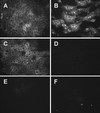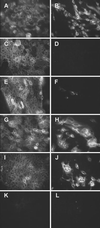Molecular determinants of species specificity in the coronavirus receptor aminopeptidase N (CD13): influence of N-linked glycosylation
- PMID: 11559807
- PMCID: PMC114546
- DOI: 10.1128/JVI.75.20.9741-9752.2001
Molecular determinants of species specificity in the coronavirus receptor aminopeptidase N (CD13): influence of N-linked glycosylation
Abstract
Aminopeptidase N (APN), a 150-kDa metalloprotease also called CD13, serves as a receptor for serologically related coronaviruses of humans (human coronavirus 229E [HCoV-229E]), pigs, and cats. These virus-receptor interactions can be highly species specific; for example, the human coronavirus can use human APN (hAPN) but not porcine APN (pAPN) as its cellular receptor, and porcine coronaviruses can use pAPN but not hAPN. Substitution of pAPN amino acids 283 to 290 into hAPN for the corresponding amino acids 288 to 295 introduced an N-glycosylation sequon at amino acids 291 to 293 that blocked HCoV-229E receptor activity of hAPN. Substitution of two amino acids that inserted an N-glycosylation site at amino acid 291 also resulted in a mutant hAPN that lacked receptor activity because it failed to bind HCoV-229E. Single amino acid revertants that removed this sequon at amino acids 291 to 293 but had one or five pAPN amino acid substitution(s) in this region all regained HCoV-229E binding and receptor activities. To determine if other N-linked glycosylation differences between hAPN, feline APN (fAPN), and pAPN account for receptor specificity of pig and cat coronaviruses, a mutant hAPN protein that, like fAPN and pAPN, lacked a glycosylation sequon at 818 to 820 was studied. This sequon is within the region that determines receptor activity for porcine and feline coronaviruses. Mutant hAPN lacking the sequon at amino acids 818 to 820 maintained HCoV-229E receptor activity but did not gain receptor activity for porcine or feline coronaviruses. Thus, certain differences in glycosylation between coronavirus receptors from different species are critical determinants in the species specificity of infection.
Figures








Similar articles
-
Mutational analysis of aminopeptidase N, a receptor for several group 1 coronaviruses, identifies key determinants of viral host range.J Virol. 2007 Feb;81(3):1261-73. doi: 10.1128/JVI.01510-06. Epub 2006 Nov 8. J Virol. 2007. PMID: 17093189 Free PMC article.
-
Feline aminopeptidase N serves as a receptor for feline, canine, porcine, and human coronaviruses in serogroup I.J Virol. 1996 Dec;70(12):8669-74. doi: 10.1128/JVI.70.12.8669-8674.1996. J Virol. 1996. PMID: 8970993 Free PMC article.
-
Characterization of functional domains in the human coronavirus HCV 229E receptor.J Gen Virol. 1996 Oct;77 ( Pt 10):2515-21. doi: 10.1099/0022-1317-77-10-2515. J Gen Virol. 1996. PMID: 8887485
-
Towards a coronavirus-based HIV multigene vaccine.Clin Dev Immunol. 2006 Jun-Dec;13(2-4):353-60. doi: 10.1080/17402520600579168. Clin Dev Immunol. 2006. PMID: 17162377 Free PMC article. Review.
-
Studying human pathogens in animal models: fine tuning the humanized mouse.Transgenic Res. 2005 Dec;14(6):803-6. doi: 10.1007/s11248-005-1676-y. Transgenic Res. 2005. PMID: 16315087 Free PMC article. Review.
Cited by
-
TMPRSS2 activates the human coronavirus 229E for cathepsin-independent host cell entry and is expressed in viral target cells in the respiratory epithelium.J Virol. 2013 Jun;87(11):6150-60. doi: 10.1128/JVI.03372-12. Epub 2013 Mar 27. J Virol. 2013. PMID: 23536651 Free PMC article.
-
CD13 mediates phagocytosis in human monocytic cells.J Leukoc Biol. 2015 Jul;98(1):85-98. doi: 10.1189/jlb.2A0914-458R. Epub 2015 May 1. J Leukoc Biol. 2015. PMID: 25934926 Free PMC article.
-
Potential Anti-COVID-19 Therapeutics that Block the Early Stage of the Viral Life Cycle: Structures, Mechanisms, and Clinical Trials.Int J Mol Sci. 2020 Jul 23;21(15):5224. doi: 10.3390/ijms21155224. Int J Mol Sci. 2020. PMID: 32718020 Free PMC article. Review.
-
Infectivity, virulence, pathogenicity, host-pathogen interactions of SARS and SARS-CoV-2 in experimental animals: a systematic review.Vet Res Commun. 2020 Nov;44(3-4):101-110. doi: 10.1007/s11259-020-09778-9. Epub 2020 Jul 10. Vet Res Commun. 2020. PMID: 32651761 Free PMC article.
-
Coronavirus reverse genetics and development of vectors for gene expression.Curr Top Microbiol Immunol. 2005;287:161-97. doi: 10.1007/3-540-26765-4_6. Curr Top Microbiol Immunol. 2005. PMID: 15609512 Free PMC article. Review.
References
-
- Ashmun R A, Holmes K V, Shapiro L H, Favaloro E J, Razak K, de Crom R P G, Howard C J, Look A T. M3 CD13 (aminopeptidase N) cluster workshop report. 1. Leucocyte typing V. In: Schlossman S F, Boumsell L, Gilks W, Harlan J M, Kishimoto T, Morimoto C, Ritz J, Shaw S, Silverstein R, Springer T, Tedder T F, Todd R F, editors. White cell differentiation antigens. Proceedings of the Fifth International Workshop and Conference. Oxford, United Kingdom: Oxford University Press; 1995. pp. 771–775.
-
- Bandres J C, Wang Q F, O'Leary J, Baleaux F, Amara A, Hoxie J A, Zolla-Pazner S, Gorny M K. Human immunodeficiency virus (HIV) envelope binds to CXCR4 independently of CD4, and binding can be enhanced by interaction with soluble CD4 or by HIV envelope deglycosylation. J Virol. 1998;72:2500–2504. - PMC - PubMed
-
- Barnes K, Kenny A J, Turner A J. Localization of aminopeptidase N and dipeptidyl peptidase IV in pig striatum and in neuronal and glial cell cultures. Eur J Neurosci. 1994;6:531–537. - PubMed
Publication types
MeSH terms
Substances
Grants and funding
LinkOut - more resources
Full Text Sources
Other Literature Sources
Molecular Biology Databases
Miscellaneous

